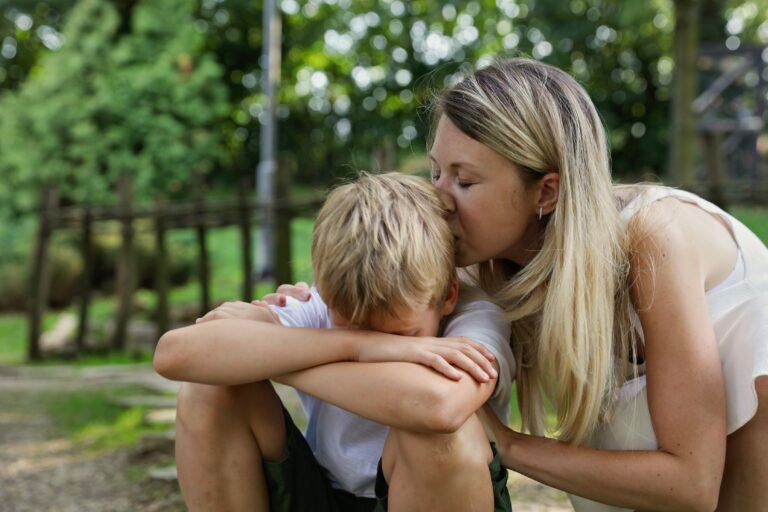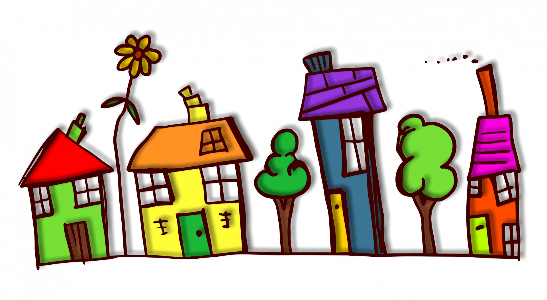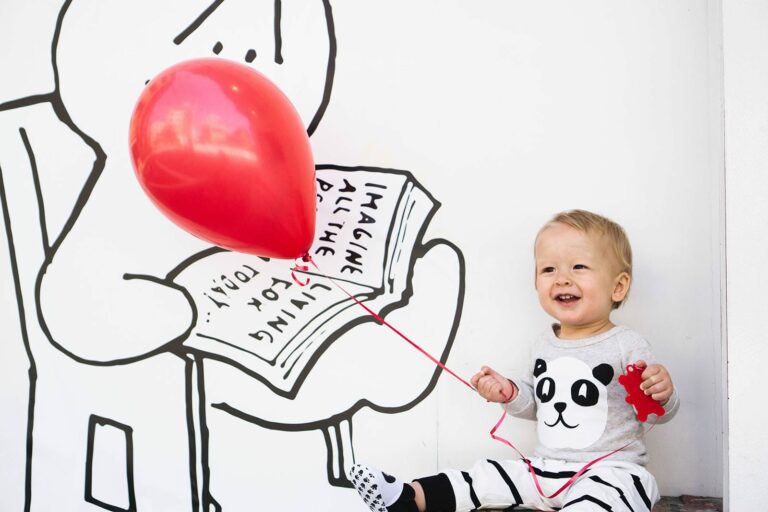My son, Sam, is 18 months and he is not yet speaking. He jabbers in his own language but has no words. I am just wondering when Sam will learn to talk? What skills does he need to have to be able to communicate with our family?
When we look at very young children there are three important aspects to communication that occur prior to a child’s first words; Receptive Language, Expressive Language and Nonverbal Communication skills. Let’s take a look at these to better help you with Sam.
Receptive Language
Receptive Language is the ability to perceive and take in information. When we speak to babies, we naturally tend to become animated, exaggerating our intonation and speak slowly with a great deal of repetition. This allows the child to hear the same word numerous times aiding the child in word identification. We say, “Bubble”, “Look bubble”, “I blow bubble”, “Wow bubbles”, “Pop, pop, pop bubbles!” We use rhythm, rhyme and repetition as we interact with babies through books and songs. As we do this, we help children learn to identify words in our language. Understanding words and phrases as well as being able to attach meaning to them is how children build a receptive vocabulary (a set of words that they understand (but cannot yet produce). Babies often recognize their own name, and words for members of the family -“mommy” or “daddy”. Also common are names for favorite toys (e.g., “ball”), objects (e.g., “diaper”), and expressions used in social routines or games, such as “boo” or “Uh oh!” are often learned early on. Learning to understand words prepares babies to be able to produce them. Before first words occur children must develop an understanding of word meanings. Receptive language is almost always greater than the child’s expressive language.
Expressive Language
Babies coo around two months of age and then expand their repertoire vocalizing with a wider range of sounds. The early sounds that your baby produces are the foundational skills for more complex expressive structures to develop. These sounds also allow your child to express different emotions. The production of babbling begins around seven to eight months of age. Babies all around the world at first produce similar sounds regardless of which language(s) they have been exposed to. At about 10 months their babbling actually begins to reflect the language they are hearing. Babbling is important as it begins to shape early word forms. At about 10 months babies begin to use babbling to communicate. They may look at you, babble and point. This is the beginning to early intentional communication.
Before 12 months, babies begin to produce word approximations. They may imitate parts of a word using the sounds they already have in their sound system. As time goes on their imitations become better and they are now producing closer approximations of the word. First words are generally related to important people, toys or things in their environment. Some early words are related to social routines such as “bye”. While we generally associate first words occurring about the same time as first steps (one year of age).
Nonverbal Communication
Before they can build an expressive vocabulary, children need to acquire a number of important prerequisite nonverbal skills. These include: understanding intentions, pointing and being able to engage in joint attention with others. Communication is social in nature. It is a two way interaction, so it is important that the child learn to attend and respond to things and people in their environment. Developing an attention span is important as babies come to realize that adults want to share attention with them and talk about what is happening in the environment. This shared attention is also called “joint attention” and it occurs when the child attends to their social partner and shifts attention between people and objects. It occurs when the child draws their partner’s attention to objects or events. It allows the two communicators to share affect, emotional states, and even perspectives. One of the most common examples of joint attention is when one person signals another person to look at an object or an event that is occurring. Nonverbal communication such as an eye gaze is an early way a child can gain an adults attention. The child may look at you and look back at a toys they are playing with as if to say, “Hey, look at this!” Prior to first words the child may also use gestures such as pointing or showing to demonstrate joint attention. Between 8 and 12 months of age babies begin to understand that adults have intentions – goals and desires. The skill of interpreting the behavior of others as intentional continues to develop during the second year of life. Understanding others’ intentions can help babies to understand what people mean by what they say. Gestures are an important aspect of nonverbal communication and pointing is one of the child’s first ways to demonstrate intentional communication. Before a child can learn to point, they must learn to follow an eye gaze to figure out what other people are interested in. Babies begin to point between 7 and 15 months of age [3]. At first they point using their whole hand, but approximately three months later they start to extend their index finger to point [5]. Pointing shows us that the child can get someone’s attention and send a message. This indicates that the child is attempting to communicate by getting an adult to do something! It is the beginning of social communication. The child points to request or ask for something such as a favorite toy or a drink of water. They also point to show or draw an adult’s attention to something. This important first gesture helps to support first words during communication.
Expected Ages – Gestures and Joint Attention
Below are the approximate age levels for gestures and joint attention [4]
Under 6 months
- Smiles with shared affect
- Whines or fusses when distressed
6-7 months
- Looking and vocalizing
- Reaching to be picked up
- Pushing away with arm
7-8 months
- Anticipatory behavior
- Reach for objects with whole hand 7 months, with vocalization – 8 months
- Pushing away with hand and vocalizing
- Showing off
- Waves in context – 8 months
9-10 months
- Reaches with open and closing hand
- Giving an object to comment
- First clapping
- Waves to prompt
- Shows objects
- Coordinated joint engagement
- The gaze alternates between object and person (9 to 14 months)
10-11 months
- Initiates social games
- Gives an object and vocalizes
- Points
- Shows and vocalizes
- Reaches with open and closed hand with vocalization
11-12 months
- Shows function of objects
- Giving an object to request an action
12-13 months
- Hugs objects
- Excited clapping
- Points to objects to request
- Points to objects combined with a word
Language is universal. Regardless of the language they speak, children develop it the same way. Of course cultural differences play a role in vocabulary and sound differences, but the same process applies. The child must perceive or take in information, they begin to express themselves with sound and also communicate nonverbally. It is important to develop the precursors to first words before we begin to expect our child to use words.
References
- Armston, R., Joint Attention and Gestures: How Do We Teach Them? ASHA Convention, November 16, 2013
- Before Their First Words, Pompeu Fabra University, Barcelona University, 2015 retrieved from http://beforefirstwords.upf.edu/precursors-of-language/.
- Colonnesi, C., Stams, G. J. J., Koster, I., & Noom, M. J. (2010). The relation between pointing and language development: A meta-analysis. Developmental Review, 30, 352–366.Lüke, C., Ritterfeld. U.,
- Crais, Elizabeth R., Douglas, Diane Day, Campbell, Cheryl Cox, (2004). The Intersection of the Development of Gestures and Intentionality, J Speech Language Hearing Research, 47: 678-694.
- 2 Grimminger, A., Liszkowski, U., & Rohlfing, K. J. (2017). Development of pointing gestures in children with typical and delayed language acquisition. Journal of Speech, Language, and Hearing Research, 60, 3185-3197.
- Weitzman, E.,” Why Interaction Must Come Before Language”, article retrieved from http://www.hanen.org/Helpful-Info/Articles/Why-Interaction-Must-Come-Before-Language.aspx November, 2018. Toronto, Ontario: Hanen Early Language Program.





